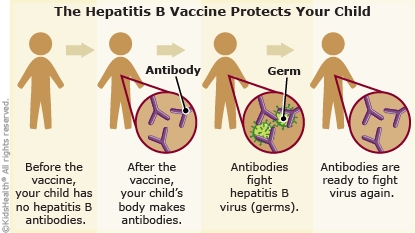After Receiving the Hepatitis B Vaccine: How to Care for Your Child
The hepatitis B vaccine (HepB) helps protect kids from hepatitis B, an illness that can cause serious long-term problems such as liver disease or liver cancer. People infected with the hepatitis B virus (HBV) also can pass the virus to other people.
The hepatitis B vaccine is made from broken-down hepatitis germs. After a child gets the vaccine, their body makes antibodies (germ-fighting proteins) against the germs. If they have contact with HBV, the antibodies fight the virus and help get rid of it before the child feels sick or the virus causes any problems. This protection usually lasts into adulthood.
The hepatitis B vaccine is given as an injection (shot). Some kids have mild side effects for 1–2 days after getting the vaccine, like soreness in the area where the shot was given or a slight fever. Very rarely, a child can have an allergic reaction right after getting the vaccine or in the hours after leaving the doctor's office.


-
If the area where the shot was given is red or swollen, place a cool wet cloth on it for 10–15 minutes every few hours.
-
Make sure your child gets any follow-up shots as recommended by the health care provider.

Your child has:

Your child:
Call 911 if your child has any signs of a serious allergic reaction. These can include hoarseness, wheezing, trouble breathing, hives, paleness, weakness, dizziness, or a fast heartbeat.

Who should get the hepatitis B vaccine? The CDC recommends that all babies get three HepB shots: the first at birth, the second at age 1–2 months, and the third at age 6–18 months. Sometimes, the HepB vaccine is given in combination with other vaccines.
The CDC also recommends HepB shots for older kids who missed any of these shots. If the mother of a newborn carries HBV in her blood, her baby must also get another shot called hepatitis B immune globulin (HBIG), which provides extra protection.